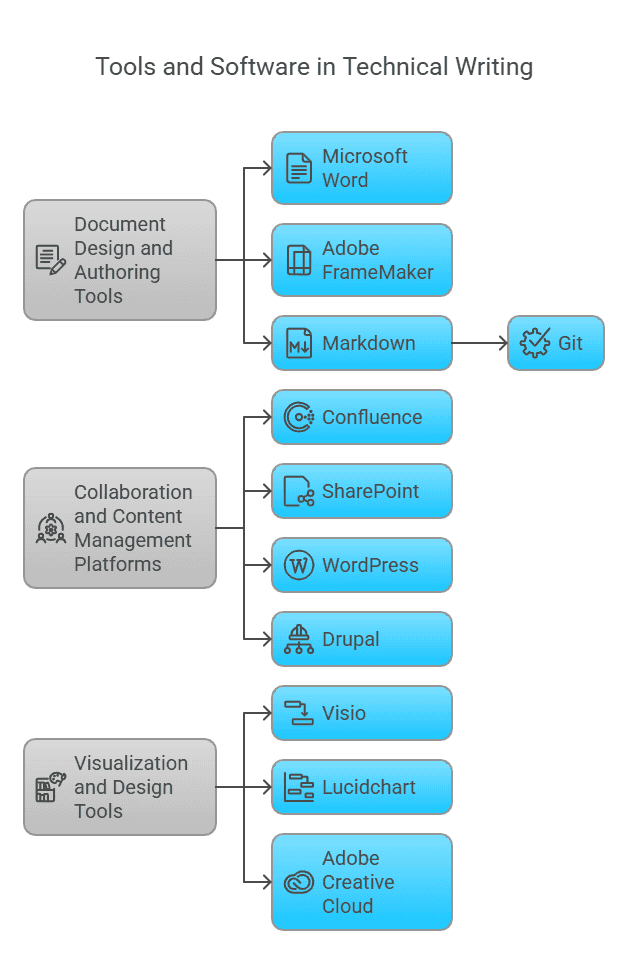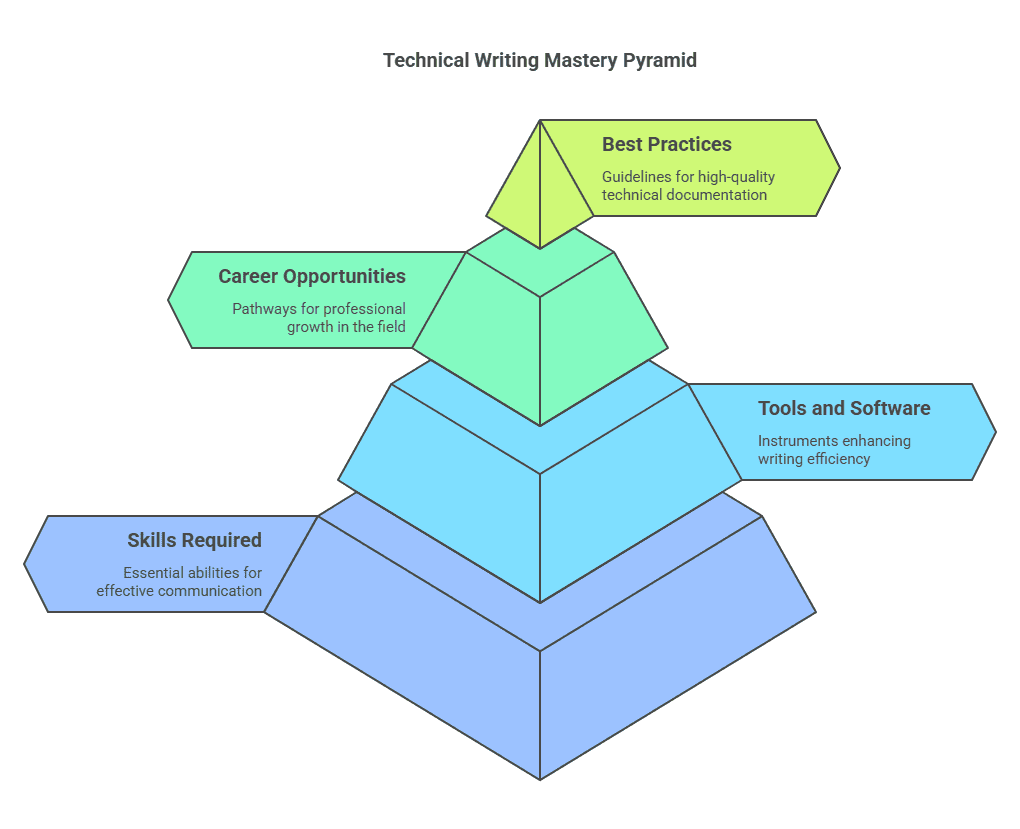Introduction
Technical writing is a cornerstone of effective communication in today’s digital age, a craft honed by precision and clarity. According to industry analytics, 67% of technical writers have attained a bachelor’s degree or higher, underscoring the educational rigor behind this field. As the anonymous adage goes, “Clarity is the soul of technical writing,” echoing the profession’s commitment to transforming complex concepts into accessible information. In an insightful thread from Technical Writing on Reddit, a user emphasized, “Breaking into technical writing is about mastering the ability to convey information succinctly,” highlighting a crucial community sentiment.
Starting a career in technical writing offers a multitude of opportunities, supported by the projected growth rate of 7% from 2020 to 2030. This promising outlook reinforces the value of technical communicators in bridging the gap between technical experts and end-users. Engaging in platforms like LinkedIn, where professionals discuss “The Role of Technical Writing in Modern Business,” reveals that 72% of companies see it as crucial to operational success, showcasing a compelling demand for these skills globally. Whether you are writing user manuals or crafting policy guidelines, technical writing remains an indispensable skill set that shapes how knowledge is shared and understood.
The Essence of Technical Writing
- At its core, technical writing is the art of taking complex, technical information and rewriting it into clear, concise, and easy-to-understand language. This skill is critical in ensuring that knowledge is accessible to varied audiences, from seasoned professionals to beginners. For instance, a technical writer might be tasked with creating an installation manual for software, where the end goal is to navigate users through a complex setup with ease. The emphasis on clarity and precision ensures that the information is not only understood but applied correctly.
- Community insights often highlight the role of clarity in technical writing. An expression frequently attributed to technical writing circles is, “Make it simple; then make it simple again.” This phrase encapsulates the iterative process that technical writers undertake to ensure the highest levels of comprehension and user satisfaction. Such clarity fosters effective communication, bridging gaps across diverse fields, from technology to finance.
Embracing the Digital Shift
- The digital transformation has had a profound impact on technical writing. The need for detailed documentation on complex systems has only grown with technological advancements. As a result, technical writing has adapted, encompassing a broader array of tools and platforms such as blogs, digital help files, and more. The integration of multimedia content also presents an engaging way for users to interact with content, offering varied forms of communication such as videos or interactive help guides.
- Moreover, the adoption of agile methodologies in product development has shaped the responsibilities of technical writers. They are now often embedded in development teams, providing an iterative approach to documentation that evolves alongside the product. This dynamic working environment not only enhances the relevancy of technical writings but also aligns closely with user and market needs.
| Section | Key Points |
|---|---|
| Essence of Technical Writing | – Translates complex technical info into clear, concise language – Aims to make knowledge accessible to all audiences – Example: Software installation manuals – Focus on clarity and precision for accurate application |
| Community Insights | – Common saying: “Make it simple; then make it simple again” – Emphasizes iterative editing for better comprehension – Ensures effective communication across diverse fields like tech and finance |
| Digital Transformation | – Increased need for detailed documentation due to tech growth – Use of modern platforms: blogs, digital help files, etc. – Inclusion of multimedia (videos, interactive guides) for engagement |
| Agile & Evolving Roles | – Agile development has reshaped technical writing roles – Writers are part of development teams – Documentation evolves iteratively with the product – Aligns documentation with user and market needs |
Importance of Technical Writing
Enhancing Communication
- Technical writing serves as the cornerstone of clear communication in specialized fields such as software, engineering, and healthcare. It translates complex technical jargon into language that is easily understood, ensuring that users and stakeholders can effectively navigate and utilize products and services. Scott Abel, a prominent figure in the technical writing community, states, “Good technical writing can make or break a product’s success,” highlighting the transformative impact effective communication can have on a product’s usability and adoption.
- Imagine a scenario where a company’s software update fails due to poorly written instructions. This not only frustrates users but can also lead to a loss of trust in the product. Technical writing mitigates such risks by providing clear documentation, thereby improving user experience and satisfaction. According to a report on LinkedIn, 72% of companies consider technical writing essential, emphasizing its vital role in seamless operational functions.
Supporting Innovation
- In fast-paced industries, innovation is critical, and technical writing supports this by ensuring that new technologies are accessible to users. Detailed, accurate documentation accelerates the dissemination of innovative solutions, allowing users to integrate new technologies into their workflows without friction. By meticulously documenting process changes and updates, technical writing drives the adoption of new products and services, thereby fostering innovation within the industry.
- Consider the healthcare industry, where precise documentation can influence the successful implementation of new medical procedures or technologies. The impact of technical writing here is profound by equipping practitioners with clear guidelines, it improves patient outcomes and enhances operational efficiency. In today’s tech-driven world, the ability to quickly adapt and access innovative tools is enhanced by robust technical documentation.
Boosting Organizational Value
- Technical writing not only aids communication and innovation but significantly boosts an organization’s overall value by enhancing efficiency and productivity. Well-documented processes provide employees with a comprehensive understanding of procedures, reducing errors and improving consistency across operations. This consistency is vital for organizations aiming for scale and precision in service delivery.
- Furthermore, technical documents such as user manuals, process guidelines, and policy documentation are not merely aids but assets that reflect an organization’s quality and reliability. As Thomas Johnson aptly notes in his influential discussions about technical writing, “The right tools can significantly enhance your technical writing efficiency.” By employing technical writing, companies build credibility and trust with their clients, ultimately improving their market position and competitive advantage.
Skills Required
Writing and Communication Skills
- Foremost among a technical writer’s skills is the ability to communicate complex information clearly and concisely. Being an adept writer is more than just having a good command of language; it involves effectively organizing and presenting information. This is critical because the audience often includes readers with varying levels of technical understanding. As Donald A. Murray succinctly states, “A good technical writer must be both a writer and a teacher,” highlighting the educational aspect of this role.
- Technical writers must tailor content according to the audience, ensuring clarity and precision without oversimplifying. They often work on user manuals or training materials that require simple, direct language to guide users step-by-step. Mastering techniques such as these not only improves usability but also boosts a writer’s ability to engage diverse audiences effectively, enhancing the overall communication strategy of an organization.
Research and Analytical Skills
- Technical writing demands robust research and analytical skills to assimilate complex concepts and transform them into accessible content. Writers often need to delve into technical details by consulting engineers, developers, or scientists, requiring them to be adept at extracting pertinent information. Comprehensive research not only informs content creation but ensures its accuracy and relevance.
- In addition to gathering information, technical writers must analyze and interpret data efficiently. They are often required to compare sources, evaluate technical documents, or appraise product functionalities. This analytical skillset enables technical writers to produce content that is not only accurate but also relevant and suited to the target audience’s needs. It positions writers as key contributors, supporting informed decision-making processes within the organization.
Technical Proficiency and Adaptability
- Staying abreast of new technologies and tools is crucial for technical writers. This proficiency ensures they can document processes in rapidly evolving fields such as software development or modern engineering. As noted by industry experts on Stack Overflow, possessing skills beyond writing, such as graphic design, enables writers to create visually appealing and functional documents, further enriching their output.
- Technical writers must also be adaptable, readily learning and integrating new frameworks or technologies into their work. This adaptability not only maximizes their efficiency but also keeps their skillset relevant as industries shift and new challenges arise. For example, a technical writer well-versed in contemporary content management systems can produce and manage documentation more effectively, maintaining an edge in a competitive market.
| Skill Area | Key Points |
|---|---|
| Writing and Communication Skills | – Communicate complex info clearly and concisely – Organize and present information effectively – Act as both writer and teacher (Donald A. Murray) – Tailor content to varied audiences – Use simple, direct language for manuals/training materials – Boost usability and audience engagement |
| Research and Analytical Skills | – Strong research abilities to understand technical concepts – Collaborate with experts (engineers, developers, scientists) – Ensure content accuracy and relevance – Analyze data and evaluate technical materials – Support decision-making with well-researched content |
| Technical Proficiency and Adaptability | – Stay updated with new tools and technologies – Document processes in fields like software or engineering – Skills like graphic design enhance document quality – Learn and apply new systems/frameworks quickly – Use of modern CMS tools for efficient documentation – Remain competitive and adaptable in changing industries |
Tools and Software

Document Design and Authoring Tools
- The backbone of many technical writing projects is a reliable document design and authoring tool. Microsoft Word remains a staple due to its comprehensive features for text formatting, image insertion, and table creation. However, for more structured documentation, many writers turn to Adobe FrameMaker, which excels in handling complex documents with advanced features like XML and DITA support. FrameMaker’s powerful tools for large documentation projects make it indispensable for writers who manage intricate document structures regularly.
- Another popular choice is Markdown, a lightweight markup language used for formatting plain text. Writers in fields that demand quick, clean documentation without the hassle of excessive design settings appreciate its simplicity. Markdown’s compatibility with version control systems like Git further aids technical teams by maintaining version histories effortlessly, thus enhancing collaborative documentation efforts.
Collaboration and Content Management Platforms
- Team collaboration and content management are critical in technical writing, especially in environments with distributed teams. Tools like Confluence and SharePoint offer robust platforms for collaboration, allowing multiple stakeholders to contribute to and refine content simultaneously. Confluence, in particular, is favored for its intuitive interface and deep integration with Atlassian’s suite of products, supporting agile documentation processes efficiently.
- Content Management Systems (CMS) like WordPress or Drupal also play a pivotal role in managing web-based technical documentation. These platforms provide flexibility in content distribution and the ability to automate documentation updates, maintaining current and accessible content across different user interfaces. Such systems are essential when technical information needs to be dynamic and easily maintained to match software updates or policy changes.
Visualization and Design Tools
- Technical writers frequently utilize visualization and design tools to enhance the comprehensibility of their documents. Tools like Visio and Lucidchart allow for the creation of detailed diagrams and flowcharts, which are crucial for visualizing complex information pathways and processes. These tools help translate abstract concepts into visual formats that readers can grasp more intuitively.
- For multimedia documents, Adobe Creative Cloud provides a breadth of applications such as Photoshop and Illustrator for image editing and design work. These tools empower writers to produce visually compelling documents that are both informative and engaging, thereby improving the user’s understanding and interaction with the documentation. Moreover, an aptitude in graphic design, as illustrated by the statistic that 60% of technical writers possess these skills, marks significant value in creating polished, professional documentation.
Career Opportunities
Overview of Technical Writing Careers
- Technical writing offers a plethora of career opportunities across various sectors such as technology, healthcare, finance, and government. This field is primarily focused on creating user-friendly documentation to convey complex information with clarity and precision. Career paths can vary significantly, from content developers, user experience writers, to specialized positions such as API writers and policy document specialists.
- Technical writers are essential in any industry where clear communication of technical information is paramount. This need becomes especially critical in companies developing software products, where user manuals, installation guides, and API documentation are routine. According to the U.S. Bureau of Labor Statistics, technical writers enjoy a median salary of $74,650, reflecting both the expertise and the indispensable role they play in organizational success.
Pathways to Enter the Field
- Aspiring technical writers can take several pathways to enter the field. Many begin their careers with a background in English or communications; however, possessing a technical background in fields like computer science or engineering can be a considerable advantage. Relevant certifications such as the Certified Professional Technical Communicator (CPTC) from the Society for Technical Communication can further enhance one’s credibility in the industry.
- Entry-level positions often involve hands-on experience through internships or junior writing roles. Gaining proficiency with industry-standard tools and software is crucial. Proficiency in software like Adobe FrameMaker, MadCap Flare, or Microsoft Word is often required. Understanding of documentation processes and a knack for instructional design can propel a novice to more significant opportunities swiftly.
Growth and Specialization
- The career trajectory for technical writers does not end at mere document creation. Over time, they can specialize in various domains. For instance, a technical writer might focus on scientific writing, transforming complex scientific research into understandable formats for broader audiences. Another specialization includes user experience (UX) design writing, where technical details meet user-centered design principles to improve product usability and customer satisfaction.
- Moreover, roles in content strategy are becoming more prevalent. These positions require a deep understanding of content management and the ability to align documentation with an organization’s strategic objectives. Getting involved in such strategic initiatives often leads to leadership roles, where one might oversee entire documentation teams or even manage cross-functional communication projects.
Best Practices
Consistency and Clarity
- One of the most critical best practices in technical writing is maintaining consistency throughout your documentation. This involves consistent use of terminology, style, and format across all documents. According to Robert W. Bly, renowned for his work in technical writing, “Consistency is key in technical writing.” Following a style guide, such as the Chicago Manual of Style or AP Style, ensures that all team members adhere to the same writing standards, which is crucial for maintaining consistency.
- Clarity is another pillar of effective technical writing. Writers should use plain language to convey complex ideas, avoiding jargon unless it is commonly understood by the target audience. Using short sentences and bullet points can enhance clarity, making the document easier to read and understand. Examples and visuals can also be employed to illustrate points clearly, bridging the gap between complex data and user comprehensibility.
User-Centric Approach
- Technical documents should focus on the end-user’s needs and capabilities. Prioritizing the user’s perspective ensures that the documentation is effective and engaging. This means writers must understand their audience’s level of expertise, adapting the content to meet these needs. User personas and feedback loops might be utilized to refine content, ensuring that it addresses the audience’s actual problems and questions.
- Moreover, usability testing is imperative to adopting a user-centric approach. By assessing how real users interact with documentation, technical writers can identify areas needing improvement. Incorporating user feedback helps to produce more intuitive and comprehensible documents that better serve their intended purpose.
Continuous Improvement
- Technical writing is not a static process. It requires constant evaluation and adaptation to new technologies and feedback. This practice ensures documents stay relevant and useful over time. Regular updates to documentation reflect software updates, new regulations, or changes in industry standards, thus maintaining their accuracy and reliability.
- Implementing a systematic review process helps in identifying outdated information. It also opens avenues for incorporating new insights or addressing previously unconsidered user queries. Tools like version control systems can assist technical writers in tracking changes and collaborating efficiently with teams. Engaging in continuous learning through courses and professional communities can further enhance a writer’s ability to deliver high-quality documentation consistently.
FAQs
What is the difference between technical writing and content writing?
Technical writing and content writing serve different purposes and target different audiences. Technical writing involves the creation of documents such as user manuals, software documentation, and instructional guides, focusing on clarity, precision, and the ability to impart complex information in a comprehensible manner. In contrast, content writing aims to engage, inform, or entertain a general audience, often found in blog posts, articles, and social media content. While technical writing necessitates a high degree of accuracy and a formal tone, content writing allows for more creativity and flexibility in style.
How can I improve my technical writing skills?
Improving technical writing skills can be achieved through continuous practice and learning. Engaging with professional communities and seeking feedback on your writing can provide valuable insights. Additionally, understanding your audience is crucial knowing their level of expertise helps tailor the content effectively. Utilizing clarity and consistency, as highlighted by experts like Donald A. Murray, can greatly enhance the readability of your documents. Furthermore, familiarizing yourself with and adhering to recognized style guides, such as the APA or Chicago Manual of Style, can standardize your writing.
What is the average salary of a technical writer?
The average salary of a technical writer can vary based on factors such as location, experience, and industry. According to the U.S. Bureau of Labor Statistics, the median annual wage for technical writers as of 2021 was $74,650. This profession is in demand across various sectors, with salary ranges reflecting the complexity and specialization of the work involved. As more industries recognize the value of clear communication, opportunities and compensation in technical writing are projected to grow.
Conclusion
In exploring the nuanced realms of technical and content writing, it is evident that each plays a crucial role in different segments of communication. Technical writing is marked by its structured approach to transforming complex information into accessible content, chiefly through documents like user manuals and instructional guides. Conversely, content writing thrives on engaging a broader audience with creative flair and compelling narratives, predominantly found in blogs and articles. These distinctions underscore the importance of clarity in technical documentation versus the creativity allowed in content writing a contrast that defines their unique contributions to effective communication strategies globally.
Enhancing technical writing skills is a journey driven by perpetual learning and community engagement, backed by the wisdom from seasoned professionals and time-tested style guides. The profession’s evolving landscape offers significant career opportunities, powered by the rising global demand for specialized knowledge dissemination. Aligning these insights with trends in salary pursuits, like those reported by the U.S. Bureau of Labor Statistics, highlights the promising growth and rewarding compensation awaiting adept technical writers. As industries increasingly value precise and clear communication, now is the time to hone technical writing skills and prepare for the expansive opportunities that lie ahead.


 Owner of Write Remotely. Connecting businesses with talented writers and empowering remote work.
Owner of Write Remotely. Connecting businesses with talented writers and empowering remote work. 

